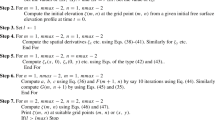Abstract
The analytical solution is derived for rotational frictional flow in a shallow layer of fluid in which the top and bottom Ekman layers join without leaving a frictionless interior. This vertical structure has significant implications for the horizontal flow. In particular, for a layer of water subjected to both a surface wind stress and bottom friction, the vorticity of the horizontal flow is a function not only of the curl of the wind stress (the classical result for deep water known as Ekman pumping) but also of its divergence. The importance of this divergence term peaks for a water depth around 3 times the Ekman layer thickness. This means that a curl-free but non-uniform wind stress on a shallow sea or lake can, through the dual action of rotation and friction, generate vorticity in the wind-driven currents. We also find that the reduction of three-dimensional dynamics to a two-dimensional model is more subtle than one could have anticipated and needs to be approached with utmost care. Taking the bottom stress as dependent solely on the depth-averaged flow, even with some veering, is not appropriate. The bottom stress ought to include a component proportional to the surface stress, which is negligible for large depths but increases with decreasing water depth.




Similar content being viewed by others
Notes
Note that this demands a flat horizontal bottom, which we had assumed from the start.
Not even in the asymptotic cases of very small or very large values.
There is some subjectivity as to where the top layer ends and the bottom one begins, obviously, but this does not need to be resolved for the sake of the argument made here.
References
Bennetts DA, Hocking LM (1973) On nonlinear Ekman and Stewartson layers in a rotating fluid. Proc R Soc Lond A 333:469–489
Cheng RT, Powell TM, Dillon TM (1976) Numerical models of wind-driven circulation in lakes. Appl Math Model 1:141–159
Cushman-Roisin B, Beckers J-M (2011) Introduction to geophysical fluid dynamics–physical and numerical aspects, 2nd edn. Academic Press, New York
Ekman VW (1923) Über Horizontalzirkulation bei winderzeugten Meeresströmungen. Arkiv Mat Astr Fysik 17:26
Forristall GZ (1974) Three-dimensional structure of storm-generated currents. J Geophys Res 79(18):2721–2729
Heaps NS (1969) A two-dimensional numerical sea model. Philos Trans R Soc A 265:93–137
Jelesnianski CP (1970) Bottom stress time-history in linearized equations of motion for storm surges. Mon Weather Rev 98(6):462–478
Józsa J (2014) On the internal boundary layer related wind stress curl and its role in generating shallow lake circulations. J Hydrol Hydromech 62(1):16–23. https://doi.org/10.2478/johh-2014-0004
Lentz S, Guza RT, Elgar S, Feddersen F, Herbers THC (1999) Momentum balances on the North Carolina inner shelf. J Geophys Res Oceans 104:18205–18226
Lick W (1976) Numerical modeling of lake currents. Ann Rev Earth Planet Sci 4:49–74
Lynch DR, Officer CB (1985) Analytic test cases for three-dimensional hydrodynamic models. Int J Numer Methods Fluids 5:529–543
Nihoul JCJ (1977) Three-dimensional model of tides and storm surges in a shallow well-mixed continental sea. Dyn Atmos Oceans 2:29–47
Price JJ, Weller RA, Schudlich RR (1987) Wind-driven ocean currents and Ekman transport. Science 238(4833):1534–1538
Schwab DJ (1983) Numerical simulation of low-frequency current fluctuations in Lake Michigan. J Phys Oceanogr 13:2213–2224
Weisberg RH, Zhang L (2008) Hurricane storm surge simulations comparing three-dimensional with two-dimensional formulations based on an Ivan-like storm over the Tampa Bay, Florida region. J Geophys Res Oceans. https://doi.org/10.1029/2008JC005115
Welander P (1957) Wind action on a shallow sea: some generalizations of Ekman’s theory. Tellus 9:45–52
Acknowledgements
The first author expresses his gratitude to Prof. GertJan van Heijst for having organized the 2017 Symposium on Shallow Flows in Eindhoven. The second author wishes to acknowledge past support from the Belgian Fund for Scientific Research (F.R.S. − FNRS) in recognition of the fact that some elements of the present paper originated while he served as Research Associate of the FNRS earlier in his career.
Author information
Authors and Affiliations
Corresponding author
Rights and permissions
About this article
Cite this article
Cushman-Roisin, B., Deleersnijder, E. Top-to-bottom Ekman layer and its implications for shallow rotating flows. Environ Fluid Mech 19, 1105–1119 (2019). https://doi.org/10.1007/s10652-018-9611-y
Received:
Accepted:
Published:
Issue Date:
DOI: https://doi.org/10.1007/s10652-018-9611-y




